Solved excessive gas tank pressure - fuel pump noise - evap problem
#1
Solved excessive gas tank pressure - fuel pump noise - evap problem
So: There are a lot of us with gas tank pressure problems and various problems related to fuel pumps. I've followed several threads on here and while this write up certainly won't be the solution for everyone, I think that if your car exhibits some of the symtoms listed below, I can definitely recommend a check of the evap system. I thought I would share my repair so that maybe it would help someone else.
Here are the symptoms my car (1982 Camaro with cross-fire, 45,000 miles) had:
1.Idle too low
2.Engine would die at stoplights
3.Incredible pressure in the gas tank, only relieved by removing the cap
4.A very loud humming/whining/droning sound coming from the gas tank. This sound is almost like a fog horn and comes from under the back seat. The sound would continue with the key off, and would stop when the gas cap was opened and the pressure released
Repairing the evap system (about $40) cured all of the symptoms listed above.
My car is a 1982 with crossfire fuel injection, other years may be slightly different, but the basics are the same. The EVAP system is incredibly simple, it is easy to test and fix and there is absolutely no reason to remove it.
There are three moving parts that can go wrong under the hood with the vapor recovery system, (1) the canister intake vacuum valve, (2) the canister outlet valve, and (3) the evap canister solenoid (which controls the canister outlet valve).
The canister intake valve is mounted in the line from the gas tank and is about 6 to 8 inches from the canister. It is on left hand side with the yellow hose clamps in the photo below. The canister outlet valve is in the center on top of the evap canister, and the evap canister solenoid is mounted on the fender to the right. (Sorry about the dates on the photos, didn't see that until I was posting this)
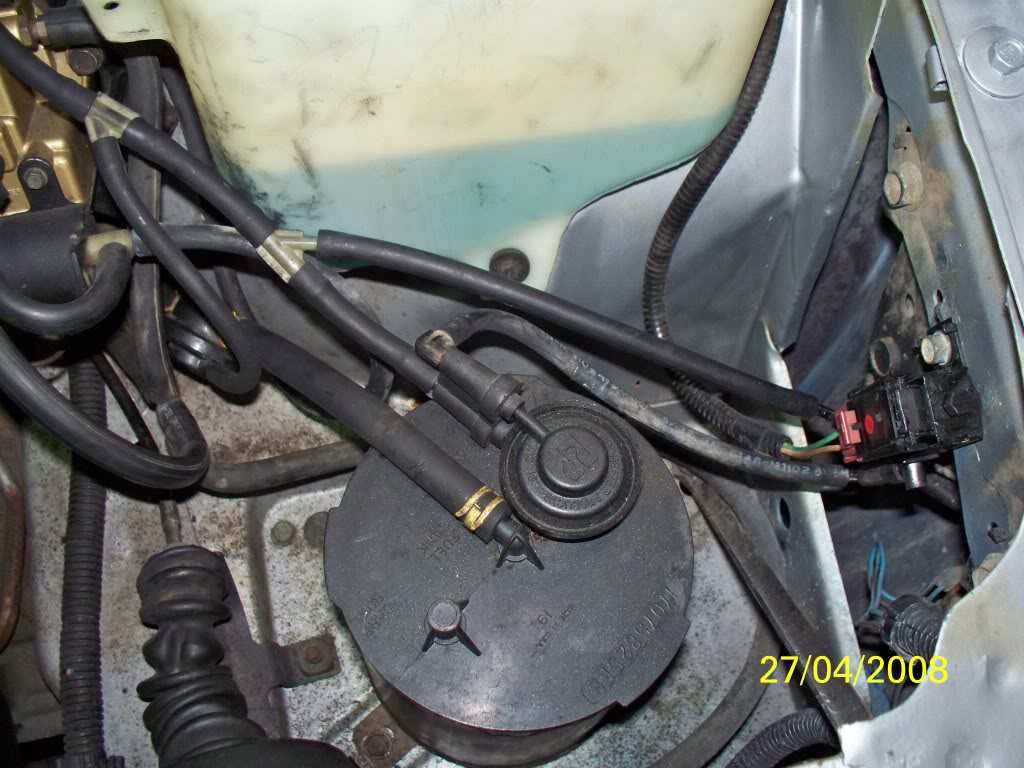
There is a lot of misinformation about the cannister inlet valve in some other threads. This valve is CLOSED when the car is off. Gas vapor cannot escape the gas tank to the canister or the engine when the car is off. As soon as the car starts and vacuum is applied to this valve it is supposed to open. So, the normal condition for this valve is closed when the car is off, and open when the car is running. The purpose of this valve is to let gas vapors into the evap canister when the engine is running, that’s it. Very simple to test, just hook up a vacuum tester and blow through the valve. It should flow air easily with a just a few psi of vacuum applied and it should hold the vacuum and not bleed down. If it doesn’t open or won’t hold a vacuum, replace it. These are readily available all over the place from Standard Products. The photo below is this valve with a vacuum tester on it. My cannister inlet valve was OK.
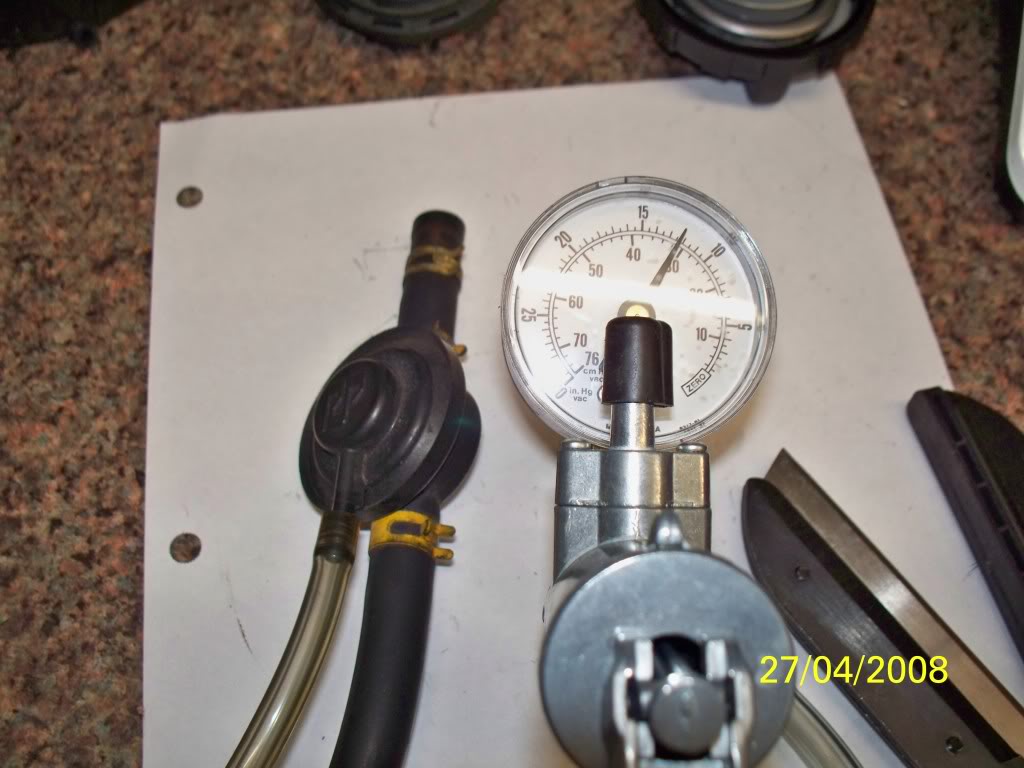
The canister outlet valve is attached to the top of the canister on my car, see the next photo below. My cannister outlet valve worked fine and held a vacuum.
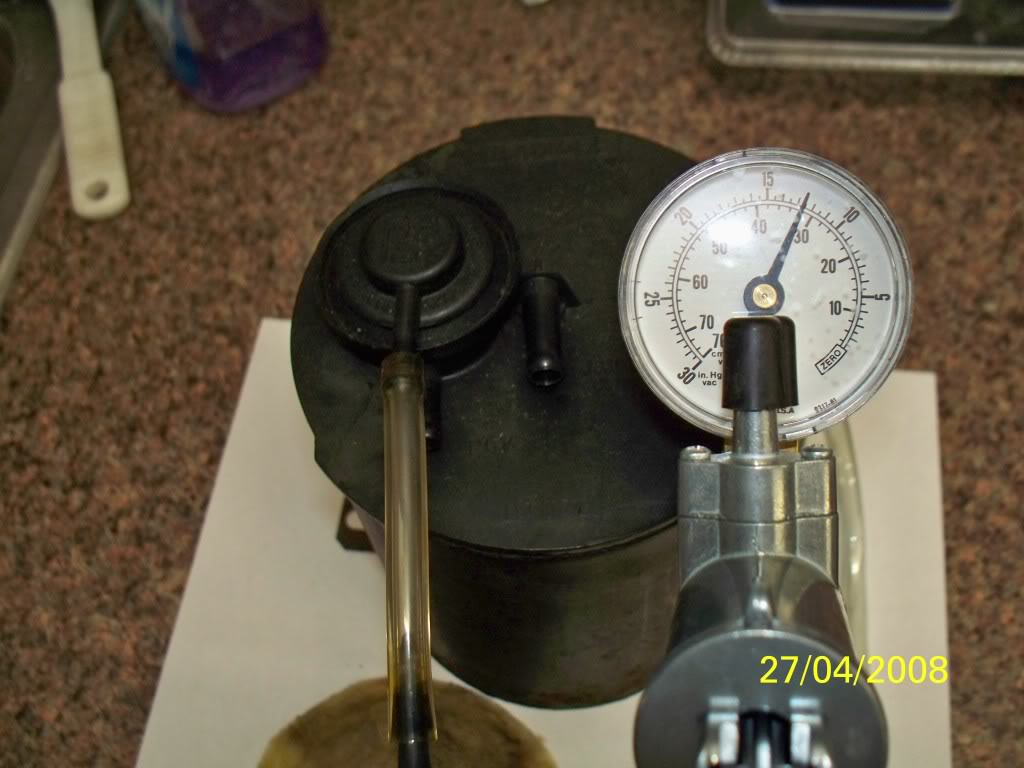
This valve is detached on newer 3rd gens, which is handy since the valve can’t be replaced on mine without buying a whole new canister. This valve is controlled by the evap canister solenoid and is CLOSED when the car is off and only supposed to be open when the engine is above idle speed. Testing is the same, apply a vacuum and see if air goes through and that the vacuum doesn’t leak down. You cannot replace this valve by itself, at least on my 1982, you need a new canister if it is faulty. Lots of similar canisters are available so getting a new one shouldn’t be too tough.
The third and final moving part in the canister system is the evap canister solenoid. The evap canister solenoid controls the canister outlet valve, and it is simply an electrical switch that turns vacuum on or off. That’s all it does. When the switch is off, (no voltage), the vacuum passageway is OPEN so that vacuum can flow through to the canister outlet valve. When the solenoid is energized with 12 volts, the switch is CLOSED, and no vacuum can get to the canister outlet valve. This is important to understand. When the car is off, the solenoid is OPEN, but there is no vacuum so the canister outlet valve stays CLOSED. When the car is on and at idle, the ECM sends 12v to the solenoid and keeps it closed. The ECM turns off the 12v at higher RPM so it is open and vacuum can get to the canister outlet valve. When functioning properly, the canister outlet valve is closed at idle and open at higher RPM. One of the symptoms people might see when this is broken is an over rich condition at idle.
On my car, the evap canister solenoid was broken but it also was leaking vacuum so I had a double whammy. Because of the vacuum leak, the canister inlet valve (which is connected to the same vacuum hose) didn’t have enough vacuum to open, and because the solenoid didn’t work, the canister outlet valve couldn’t ever work either. Bottom line, my car had no way to vent the tank so gas vapors built up, plus, there was a direct vacuum leak through the solenoid to the engine causing idle problems.
Testing the solenoid is easy, hook it up to 12 volts and blow air through it. With 12 volts through it, it should be CLOSED. Take the power off and it should open. If not, it needs to be replaced.
The canister solenoid valve is not available from the dealer any more, and if you go to any parts house they will look it up and bring out the wrong part every time. Don’t know why, but for my 1982 at least, they don’t have a clue. Once again, Standard Products comes to the rescue. The part number you need is CP201 see the photos below. It is nearly an exact replacement except that the vacuum line fittings are slightly larger and the distance between them is different. I cut a couple of short pieces of vacuum line to replaced the factory molded elbows.
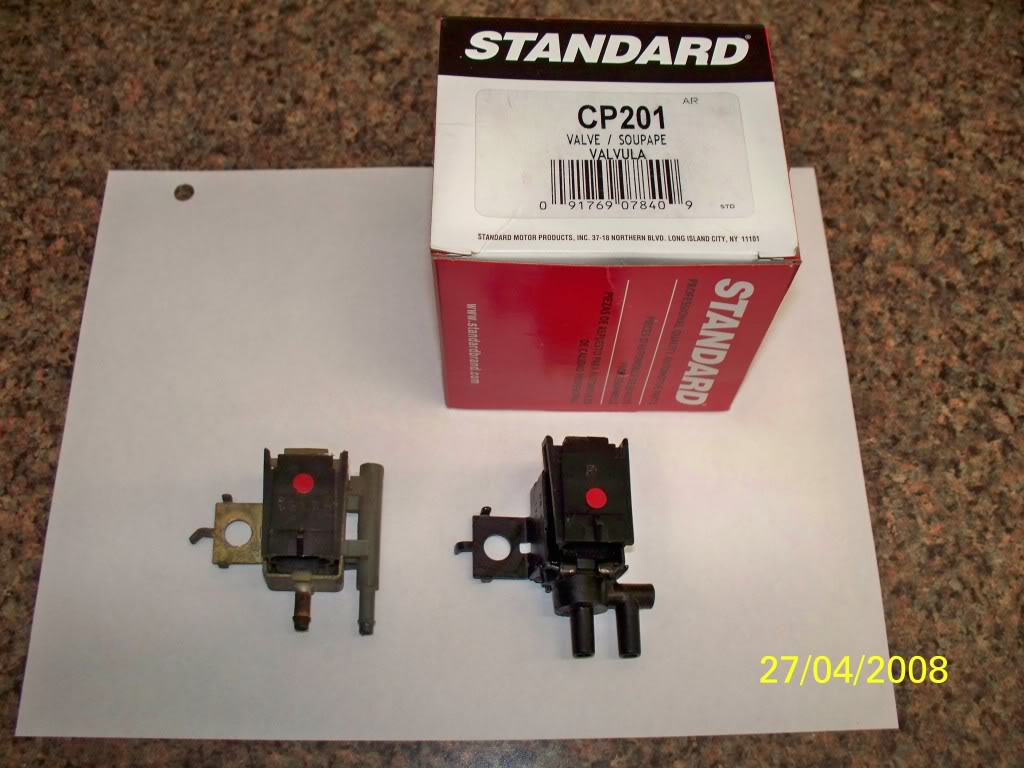
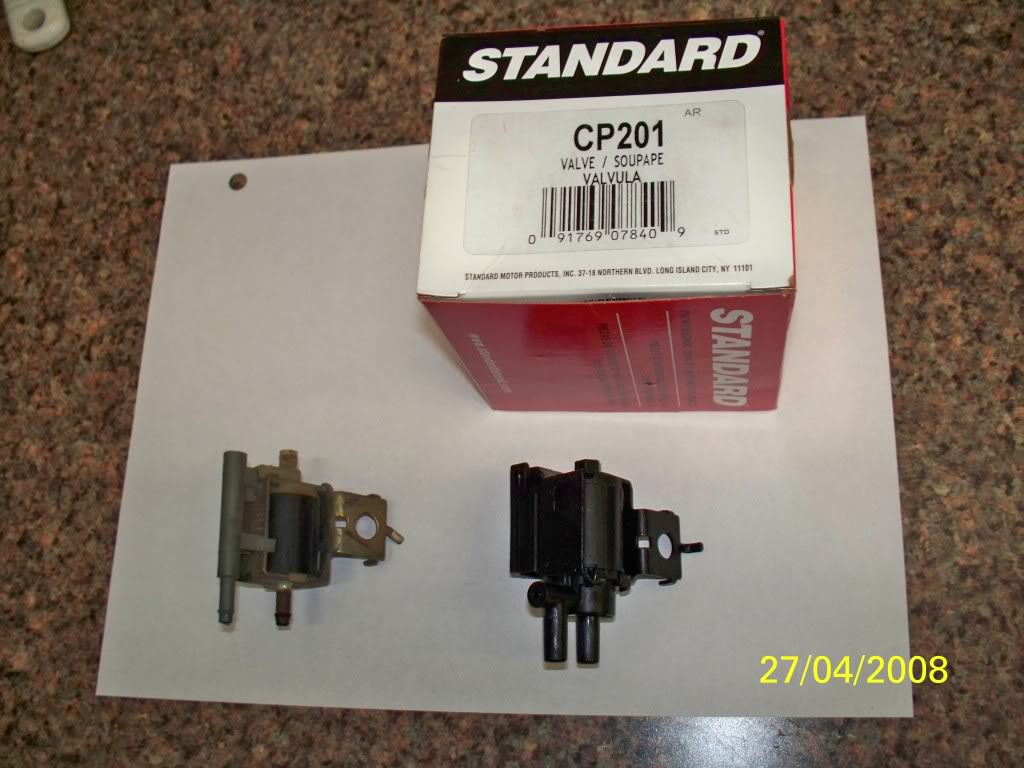
So back to the symptoms (which are all gone now BTW):
1.Idle too low – from the vacuum leak? or from excessive pressure in the tank?
2.Engine would die at stoplights – See #1.
3.Incredible pressure in the gas tank, only relieved by removing the cap – evap gas could not get it into the canister or get out either. Nowhere to go, so it would build up until I took the cap off or the pressure relief valve hit its limit.
4. Loud humming/whining sound coming from the gas tank. Turns out the sound that I thought was a bad fuel pump was actually from the pressure relief valve which is located right under the tank very close to the fuel pump. To help with your diagnosis, the big difference between a bad fuel pump and the pressure relief valve going off is that the relief valve keeps making noise after the KEY WAS OFF. Opening the gas cap also made it stop, but watch out for flying gas caps.
Few final notes:
There is no vented gas cap for these cars. If you ask at the parts store, all you will do is confuse the counter guy. While I was waiting for my new evap canister solenoid to arrive, I made a vented cap by buying an extra gas cap for my car ($3.25) and drilling a small hole in the inner liner but not all the way through the outer cap. Just mark the cap position when it is on and drill a tiny hole at the 12 o’clock position from the inside of the cap. Works great and solves the pressure buildup problem quick and easy until you get the evap stuff fixed. The factory cap has a pressure relief valve built in, it is not a vent. See photos below
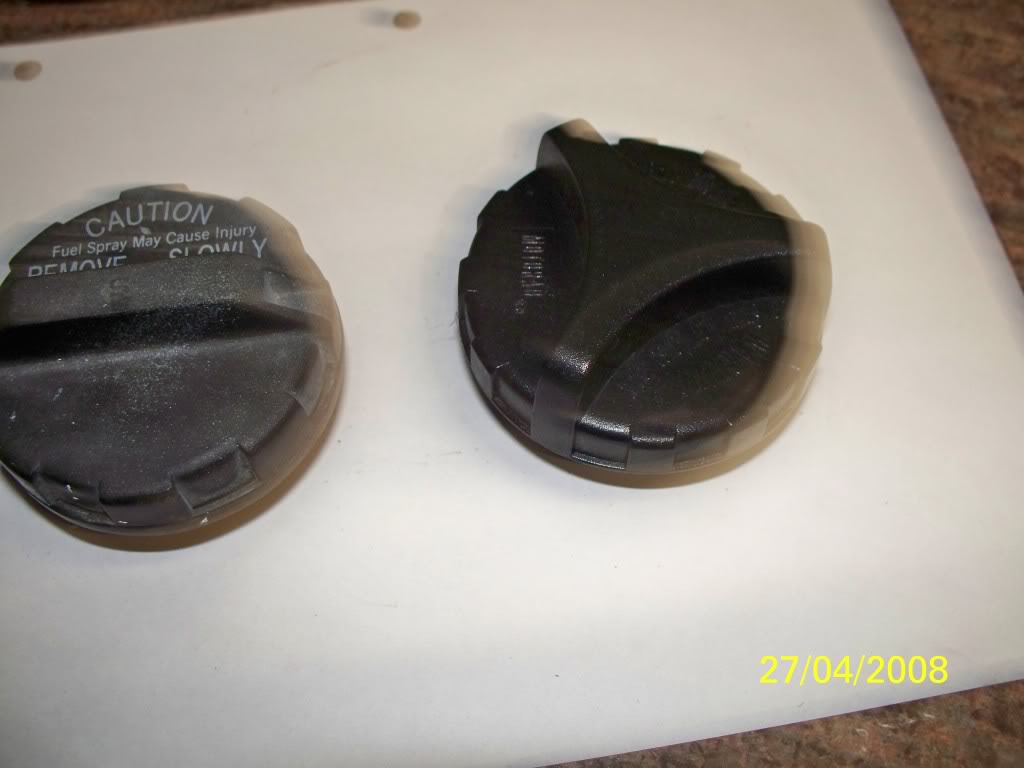
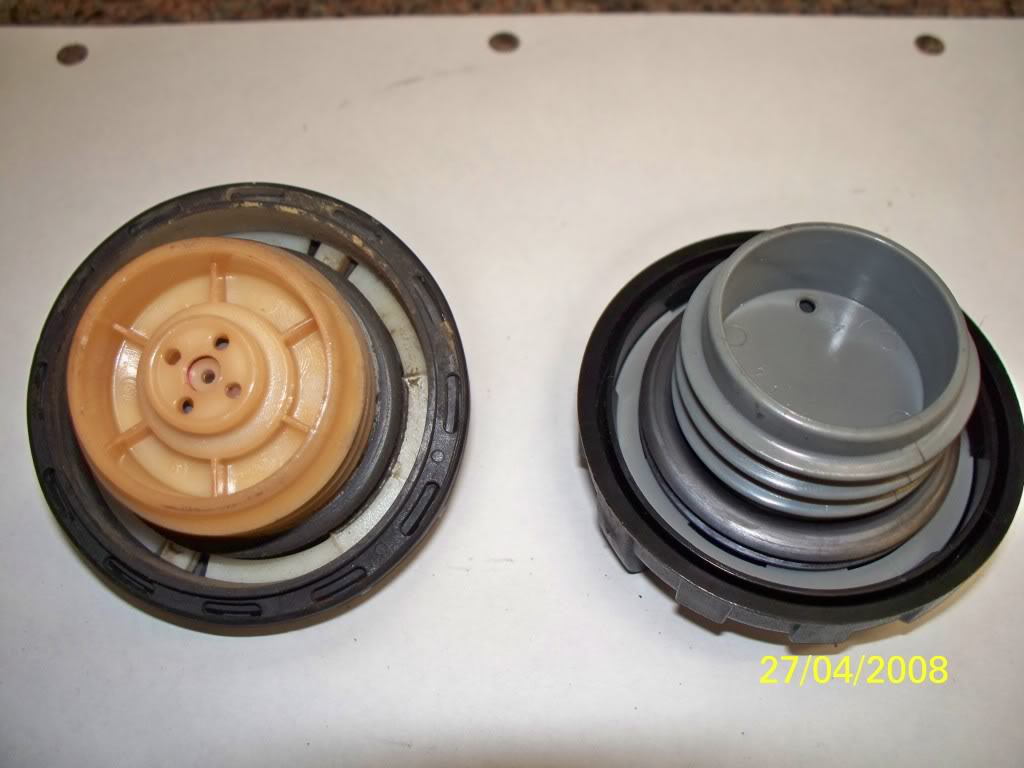
The evap canister “filter” is available anywhere. There is a one way relief valve on the bottom of the canister and all this does is let fresh air into the canister through the bottom if vacuum builds up too much. The filter is to make sure no crud gets sucked in to your intake.
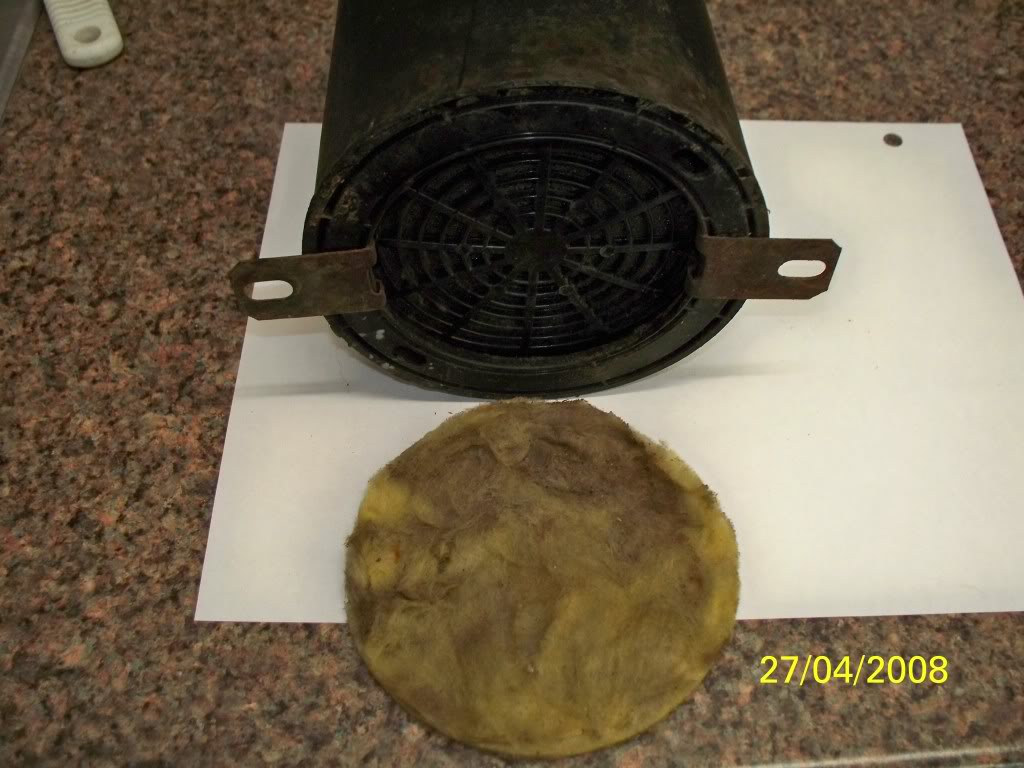
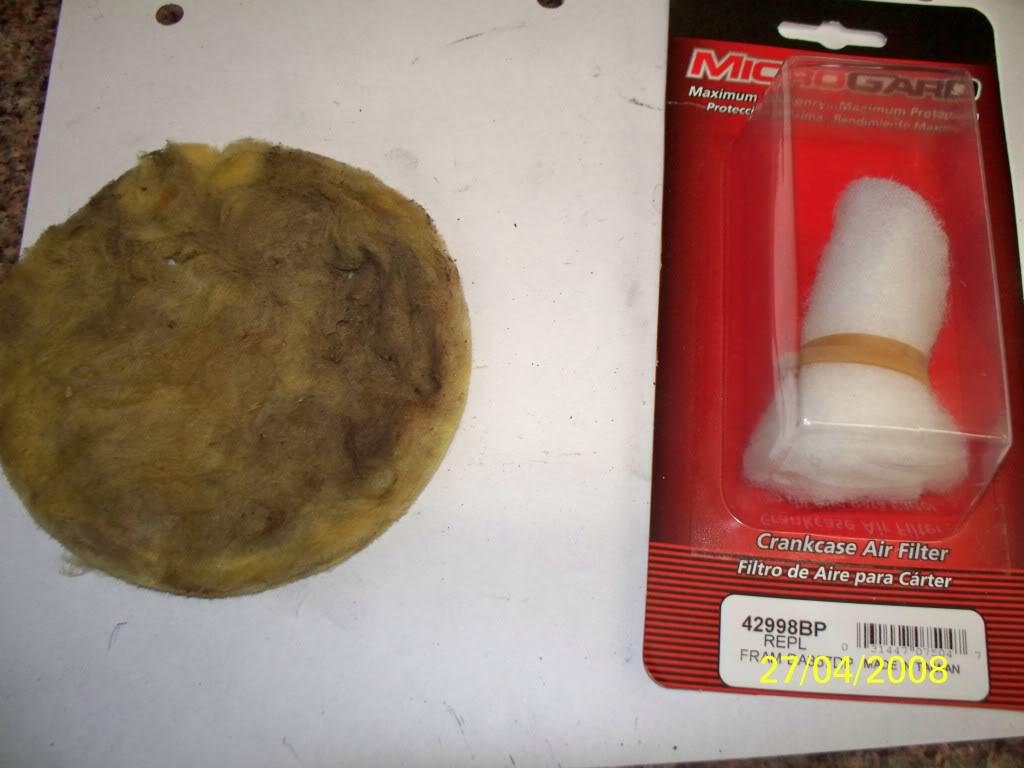
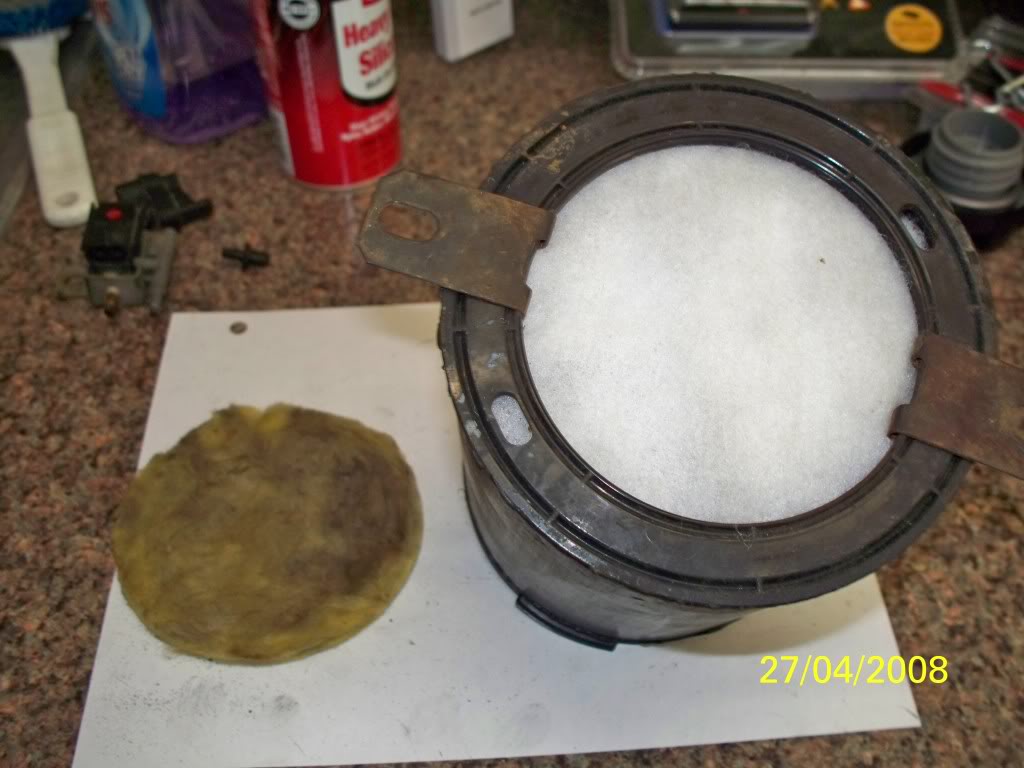
So that’s it, hope this helps someone else out.
Here are the symptoms my car (1982 Camaro with cross-fire, 45,000 miles) had:
1.Idle too low
2.Engine would die at stoplights
3.Incredible pressure in the gas tank, only relieved by removing the cap
4.A very loud humming/whining/droning sound coming from the gas tank. This sound is almost like a fog horn and comes from under the back seat. The sound would continue with the key off, and would stop when the gas cap was opened and the pressure released
Repairing the evap system (about $40) cured all of the symptoms listed above.
My car is a 1982 with crossfire fuel injection, other years may be slightly different, but the basics are the same. The EVAP system is incredibly simple, it is easy to test and fix and there is absolutely no reason to remove it.
There are three moving parts that can go wrong under the hood with the vapor recovery system, (1) the canister intake vacuum valve, (2) the canister outlet valve, and (3) the evap canister solenoid (which controls the canister outlet valve).
The canister intake valve is mounted in the line from the gas tank and is about 6 to 8 inches from the canister. It is on left hand side with the yellow hose clamps in the photo below. The canister outlet valve is in the center on top of the evap canister, and the evap canister solenoid is mounted on the fender to the right. (Sorry about the dates on the photos, didn't see that until I was posting this)

There is a lot of misinformation about the cannister inlet valve in some other threads. This valve is CLOSED when the car is off. Gas vapor cannot escape the gas tank to the canister or the engine when the car is off. As soon as the car starts and vacuum is applied to this valve it is supposed to open. So, the normal condition for this valve is closed when the car is off, and open when the car is running. The purpose of this valve is to let gas vapors into the evap canister when the engine is running, that’s it. Very simple to test, just hook up a vacuum tester and blow through the valve. It should flow air easily with a just a few psi of vacuum applied and it should hold the vacuum and not bleed down. If it doesn’t open or won’t hold a vacuum, replace it. These are readily available all over the place from Standard Products. The photo below is this valve with a vacuum tester on it. My cannister inlet valve was OK.

The canister outlet valve is attached to the top of the canister on my car, see the next photo below. My cannister outlet valve worked fine and held a vacuum.

This valve is detached on newer 3rd gens, which is handy since the valve can’t be replaced on mine without buying a whole new canister. This valve is controlled by the evap canister solenoid and is CLOSED when the car is off and only supposed to be open when the engine is above idle speed. Testing is the same, apply a vacuum and see if air goes through and that the vacuum doesn’t leak down. You cannot replace this valve by itself, at least on my 1982, you need a new canister if it is faulty. Lots of similar canisters are available so getting a new one shouldn’t be too tough.
The third and final moving part in the canister system is the evap canister solenoid. The evap canister solenoid controls the canister outlet valve, and it is simply an electrical switch that turns vacuum on or off. That’s all it does. When the switch is off, (no voltage), the vacuum passageway is OPEN so that vacuum can flow through to the canister outlet valve. When the solenoid is energized with 12 volts, the switch is CLOSED, and no vacuum can get to the canister outlet valve. This is important to understand. When the car is off, the solenoid is OPEN, but there is no vacuum so the canister outlet valve stays CLOSED. When the car is on and at idle, the ECM sends 12v to the solenoid and keeps it closed. The ECM turns off the 12v at higher RPM so it is open and vacuum can get to the canister outlet valve. When functioning properly, the canister outlet valve is closed at idle and open at higher RPM. One of the symptoms people might see when this is broken is an over rich condition at idle.
On my car, the evap canister solenoid was broken but it also was leaking vacuum so I had a double whammy. Because of the vacuum leak, the canister inlet valve (which is connected to the same vacuum hose) didn’t have enough vacuum to open, and because the solenoid didn’t work, the canister outlet valve couldn’t ever work either. Bottom line, my car had no way to vent the tank so gas vapors built up, plus, there was a direct vacuum leak through the solenoid to the engine causing idle problems.
Testing the solenoid is easy, hook it up to 12 volts and blow air through it. With 12 volts through it, it should be CLOSED. Take the power off and it should open. If not, it needs to be replaced.
The canister solenoid valve is not available from the dealer any more, and if you go to any parts house they will look it up and bring out the wrong part every time. Don’t know why, but for my 1982 at least, they don’t have a clue. Once again, Standard Products comes to the rescue. The part number you need is CP201 see the photos below. It is nearly an exact replacement except that the vacuum line fittings are slightly larger and the distance between them is different. I cut a couple of short pieces of vacuum line to replaced the factory molded elbows.


So back to the symptoms (which are all gone now BTW):
1.Idle too low – from the vacuum leak? or from excessive pressure in the tank?
2.Engine would die at stoplights – See #1.
3.Incredible pressure in the gas tank, only relieved by removing the cap – evap gas could not get it into the canister or get out either. Nowhere to go, so it would build up until I took the cap off or the pressure relief valve hit its limit.
4. Loud humming/whining sound coming from the gas tank. Turns out the sound that I thought was a bad fuel pump was actually from the pressure relief valve which is located right under the tank very close to the fuel pump. To help with your diagnosis, the big difference between a bad fuel pump and the pressure relief valve going off is that the relief valve keeps making noise after the KEY WAS OFF. Opening the gas cap also made it stop, but watch out for flying gas caps.
Few final notes:
There is no vented gas cap for these cars. If you ask at the parts store, all you will do is confuse the counter guy. While I was waiting for my new evap canister solenoid to arrive, I made a vented cap by buying an extra gas cap for my car ($3.25) and drilling a small hole in the inner liner but not all the way through the outer cap. Just mark the cap position when it is on and drill a tiny hole at the 12 o’clock position from the inside of the cap. Works great and solves the pressure buildup problem quick and easy until you get the evap stuff fixed. The factory cap has a pressure relief valve built in, it is not a vent. See photos below


The evap canister “filter” is available anywhere. There is a one way relief valve on the bottom of the canister and all this does is let fresh air into the canister through the bottom if vacuum builds up too much. The filter is to make sure no crud gets sucked in to your intake.



So that’s it, hope this helps someone else out.
#3
Moderator

iTrader: (1)
Join Date: Mar 2002
Location: Chasing Electrons
Posts: 18,399
Likes: 0
Received 215 Likes
on
201 Posts
Car: check
Engine: check
Transmission: check
Re: Solved excessive gas tank pressure - fuel pump noise - evap problem
There is a lot of misinformation about the canister inlet valve in some other threads. This valve is CLOSED when the car is off. Gas vapor cannot escape the gas tank to the canister or the engine when the car is off. As soon as the car starts and vacuum is applied to this valve it is supposed to open. So, the normal condition for this valve is closed when the car is off, and open when the car is running.
Tank pressure on the other side of the valve will do the same thing.
The evap system changed a lot over the years, so reading other threads that are relative to a different year or even engine this needs to be kept in mind. An example is the '92 MY, solid gas cap, has the in/out vent as a separate item off the tank sender unit.
The vapor control valve (inlet valve) is not connected to a vacuum source, and the purge solenoid is mounted on the canister and is normally open (all '92 MY 3rd gens?). The canister design is different as it has a solid bottom and a separate air vent on the top.
Overall it is a much simpler system then the earlier cars.
RBob.
#7
Re: Solved excessive gas tank pressure - fuel pump noise - evap problem
Trending Topics
#8
Junior Member
Re: Solved excessive gas tank pressure - fuel pump noise - evap problem
In pouring over the various threads on excessive fuel-tank pressure, sending unit, and the evap system, I too am troubleshooting similar issues (fuel-pump or vent-valve howling and gas vapor fumes from the rear of the car) and following the advice from various sources during the troubleshoot –thanks to all for your suggestions. This thread is particularly helpful.
While I’m diagnosing the evap system, what I have not read in any of the threads thus far is whether the excessive fuel-tank pressure can arise if…
a) ...the rollover value/vapor restrictor-to-canister tube is mis-plumbed to the vent-valve and vice-versa and/or;
b) …the rollover valve/vapor restrictor is non-functional or faulty?
I ask these questions because I had the sending unit (Dorman) and fuel-pump (Delphi) replaced and I almost immediately experienced similar issues (howling noise and gas vapor) after 30 minutes or so of operation on warm/hot days - it’s progressively worsening.
Thanks in advance and any further suggestions would be greatly appreciated.
While I’m diagnosing the evap system, what I have not read in any of the threads thus far is whether the excessive fuel-tank pressure can arise if…
a) ...the rollover value/vapor restrictor-to-canister tube is mis-plumbed to the vent-valve and vice-versa and/or;
b) …the rollover valve/vapor restrictor is non-functional or faulty?
I ask these questions because I had the sending unit (Dorman) and fuel-pump (Delphi) replaced and I almost immediately experienced similar issues (howling noise and gas vapor) after 30 minutes or so of operation on warm/hot days - it’s progressively worsening.
Thanks in advance and any further suggestions would be greatly appreciated.
#11
Junior Member
iTrader: (1)
Join Date: Jul 2012
Location: Alabama
Posts: 21
Likes: 0
Received 0 Likes
on
0 Posts
Car: 1986 IROC-Z28
Engine: 305 TPI
Transmission: 700R4
Axle/Gears: 3.23
Re: Solved excessive gas tank pressure - fuel pump noise - evap problem
tag -
Just a theory - but I quit running ethanol in my car and haven't seemed to have the problem.
Just a theory - but I quit running ethanol in my car and haven't seemed to have the problem.
#12
Junior Member
Re: Solved excessive gas tank pressure - fuel pump noise - evap problem
In pouring over the various threads on excessive fuel-tank pressure, sending unit, and the evap system, I too am troubleshooting similar issues (fuel-pump or vent-valve howling and gas vapor fumes from the rear of the car) and following the advice from various sources during the troubleshoot –thanks to all for your suggestions. This thread is particularly helpful.
While I’m diagnosing the evap system, what I have not read in any of the threads thus far is whether the excessive fuel-tank pressure can arise if…
a) ...the rollover value/vapor restrictor-to-canister tube is mis-plumbed to the vent-valve and vice-versa and/or;
b) …the rollover valve/vapor restrictor is non-functional or faulty?
I ask these questions because I had the sending unit (Dorman) and fuel-pump (Delphi) replaced and I almost immediately experienced similar issues (howling noise and gas vapor) after 30 minutes or so of operation on warm/hot days - it’s progressively worsening.
Thanks in advance and any further suggestions would be greatly appreciated.
While I’m diagnosing the evap system, what I have not read in any of the threads thus far is whether the excessive fuel-tank pressure can arise if…
a) ...the rollover value/vapor restrictor-to-canister tube is mis-plumbed to the vent-valve and vice-versa and/or;
b) …the rollover valve/vapor restrictor is non-functional or faulty?
I ask these questions because I had the sending unit (Dorman) and fuel-pump (Delphi) replaced and I almost immediately experienced similar issues (howling noise and gas vapor) after 30 minutes or so of operation on warm/hot days - it’s progressively worsening.
Thanks in advance and any further suggestions would be greatly appreciated.
After trying to isolate the apparent increase in fuel-tank pressure as well as identifying why the internal fuel pump after about 30 min of continuous operations makes more noise than after initial cold-engine start, these are the steps I followed/results found:
a) Fuel tank vent valve (behind driver, external to and forward of tank): I measured both the ability of the vent value to hold pressure and vacuum. In the case of holding vacuum (that is, allowing air into the tank as fuel is consumed), the vent valve doesn’t hold any vacuum – normal behavior. In the case of holding pressure, I found that the valve vented at about 2 psi. The sound the valve made in venting 2 psi was pretty minor. I used a MityVac MV8255 for applying pressure and vacuum.
b) Fuel tank pressure control valve (plumbed between the fuel tank and the EVAP canister, OE part number 17085762 or AC Delco 214-2294): The valve’s 3 ports are labeled as: (2) bottom ports – TANK and CANister and (1) top port for VACuum. Applying pressure to the TANK port in absence of VAC, the valve vents to CAN at ~2 psi. In the opposite direction, the valve holds pressure when applying pressure to CAN in absence of VAC. In applying 15” Hg to the VAC port, the valve’s diaphragm held to 5” Hg after ~20 sec. Result: tank pressure control valve in good working order.
c) EVAP canister fuel vapor control valve (OE p/n 17075852) + canister purge solenoid: For my model year 85, the control valve integrated into the EVAP canister has two ports: a top port for manifold vacuum and a bottom port that is plumbed to the operated-by-the ECM purge valve.
In the absence of vacuum applied to the top port, I observed stored vapors in the canister could not be withdrawn. With vacuum applied to the top port, I observed that air was drawn in from the bottom of the canister allowed stored vapors in the canister to be withdrawn by the purge valve when enabled by the ECM.
d) The last item to check was the DCR and the operation of the canister purge solenoid. The measured DCR was 25ohms and was within spec. When the solenoid was energized as ECM would, I observed that stored vapors in the canister would be drawn into the manifold with vacuum applied to fuel vapor control valve. Net result: EVAP canister fuel vapor control valve, canister purge solenoid, and canister were all in good working order.
d) With these results, the next item I checked was to determine if there was any blockage in the TANK-to-CANISTER plumbing. With the gas cap off, I attempted to apply pressure and noted that the plumbing back to the tank was clear. Even though no blockage was detected, there’s no way of knowing conclusively whether the plumbing is correct at the sender (TANK-to-CANISTER and VENT to Vent Valve) without physically examining the plumbing.
While I’ve found sending-unit tech support at Spectra Premium helpful, it would be great if one of the other members of Third Gen who’ve replaced the fuel tank and sending unit could confirm the following for me:
a) External vent valve to sending-unit vent pipe hose: 3/8" dia
b) Evap canister to sending-unit rollover valve pipe hose: 1/4" dia
c) Fuel return to sending-unit fuel-return pipe hose: 5/16" dia
d) Fuel feed to sending-unit fuel-feed pipe hose: 3/8" dia
Unless this all checks out, the only other conclusion I can draw is that there’s some type of interaction between the internal fuel pump (a Delphi product), the sending unit (a Dorman product), and the new fuel tank (a Dorman product as well) that’s causing the internal fuel pump to generate
Any other suggestions from the members would be greatly appreciated - thanks.
#13
Member
Join Date: Jun 2016
Location: Upstate SC
Posts: 137
Likes: 0
Received 1 Like
on
1 Post
Car: 1985 Pontiac Firebird Trans Am
Engine: 305 LG4
Transmission: 700R4 Automagic
Axle/Gears: No clue
Re: Solved excessive gas tank pressure - fuel pump noise - evap problem
So when I bought my car most emissions stuff had been removed. I decided to also remove the old and busted charcoal canister and put a nice little filter on the line. My question now is...I still have the pressure control valve on the line between the filter and the tank. So do I need to just cap off the vac connection on it? Should I connect it to the proper vacuum source on my carb? Or should I remove it entirely? I'm pretty sure it still works because if I blow hard enough I can get some air through it. I can say I also get a good amount of hissing when I remove the gas cap, but I don't think I have any other noises associated with it.
#14
Supreme Member

iTrader: (2)
Join Date: Jan 2005
Location: S. UTAH
Posts: 1,237
Likes: 0
Received 160 Likes
on
132 Posts
Car: 1989 IROC-Z 305 LB9 AT Convertible
Engine: LB9 305
Transmission: AT
Re: Solved excessive gas tank pressure - fuel pump noise - evap problem
Should be a sticky, IMO. Subscribed. Good JOB!
The following users liked this post:
a968 (06-06-2023)
#15
Member
Join Date: May 2015
Location: Centennial, CO
Posts: 104
Likes: 0
Received 0 Likes
on
0 Posts
Car: 1987 Trans Am
Engine: 355 Edel Int, SLP, Edel heders 8PSI
Transmission: T5
Axle/Gears: 3.45 Borg Warner
Re: Solved excessive gas tank pressure - fuel pump noise - evap problem
How are you making out with this?
#16
Supreme Member

iTrader: (2)
Join Date: Jan 2005
Location: S. UTAH
Posts: 1,237
Likes: 0
Received 160 Likes
on
132 Posts
Car: 1989 IROC-Z 305 LB9 AT Convertible
Engine: LB9 305
Transmission: AT
Re: Solved excessive gas tank pressure - fuel pump noise - evap problem
OP, SO, maybe I missed it, but is this solved? If so, What was the cause?
#17
Senior Member
iTrader: (1)
Join Date: May 2014
Location: Pittsburgh
Posts: 550
Likes: 0
Received 5 Likes
on
5 Posts
Car: 91 G92 Z28
Engine: 305 TPI
Transmission: T5
Axle/Gears: 342
Re: Solved excessive gas tank pressure - fuel pump noise - evap problem
Sorry to revive this old thread, but originally 69 Z11 (threadstarter) said that:
"Testing the solenoid is easy, hook it up to 12 volts and blow air through it. With 12 volts through it, it should be CLOSED. Take the power off and it should open. If not, it needs to be replaced."
Am I crazy or is this statement actually the opposite of what happens when you put 12v to the valve?
In my car (TPI car) when I apply 12v to the valve it opens and air will pass through the valve/canister. When you take power away from the valve it closes. Which is the exact opposite of what was originally written. My understanding is that the 12v lead to the valve is always hot when the ignition is on. So the only way the valve will open is if the ECU gives a signal (under certain conditions) to short out the ground which in turn opens the purge solenoid valve and sends the fumes into the throttle body/intake to be burned off.
Any any case my car never seems to get the signal to ground that circuit from the ecu to open the valve. So I get the same tank pressure problem that so may others appear to be having.
My prom has been tuned (mail order) to remove the smog and egr. I'm starting to think perhaps the tuner did something in there that is causing the solenoid to never switch to ground. Thoughts?
"Testing the solenoid is easy, hook it up to 12 volts and blow air through it. With 12 volts through it, it should be CLOSED. Take the power off and it should open. If not, it needs to be replaced."
Am I crazy or is this statement actually the opposite of what happens when you put 12v to the valve?
In my car (TPI car) when I apply 12v to the valve it opens and air will pass through the valve/canister. When you take power away from the valve it closes. Which is the exact opposite of what was originally written. My understanding is that the 12v lead to the valve is always hot when the ignition is on. So the only way the valve will open is if the ECU gives a signal (under certain conditions) to short out the ground which in turn opens the purge solenoid valve and sends the fumes into the throttle body/intake to be burned off.
Any any case my car never seems to get the signal to ground that circuit from the ecu to open the valve. So I get the same tank pressure problem that so may others appear to be having.
My prom has been tuned (mail order) to remove the smog and egr. I'm starting to think perhaps the tuner did something in there that is causing the solenoid to never switch to ground. Thoughts?
#18
Moderator

iTrader: (1)
Join Date: Mar 2002
Location: Chasing Electrons
Posts: 18,399
Likes: 0
Received 215 Likes
on
201 Posts
Car: check
Engine: check
Transmission: check
Re: Solved excessive gas tank pressure - fuel pump noise - evap problem
From post #3:
"The evap system changed a lot over the years, so reading other threads that are relative to a different year or even engine this needs to be kept in mind. An example is the '92 MY, solid gas cap, has the in/out vent as a separate item off the tank sender unit."
As for the CCP solenoid, GM used both NO and NC devices on our 3rd gens.
Note that the solenoid has nothing to do with venting the tank. It only controls when the engine gets to burn the purged fumes from the canister.
RBob.
"The evap system changed a lot over the years, so reading other threads that are relative to a different year or even engine this needs to be kept in mind. An example is the '92 MY, solid gas cap, has the in/out vent as a separate item off the tank sender unit."
As for the CCP solenoid, GM used both NO and NC devices on our 3rd gens.
Note that the solenoid has nothing to do with venting the tank. It only controls when the engine gets to burn the purged fumes from the canister.
RBob.
#19
Supreme Member

iTrader: (4)
Join Date: Dec 2001
Location: Chicagoland
Posts: 9,666
Received 546 Likes
on
376 Posts
Car: 1989 IROC-Z. Original owner
Engine: LB9. Dual Cats. Big Cam
Transmission: World Class T-5
Axle/Gears: BW 3.45
Re: Solved excessive gas tank pressure - fuel pump noise - evap problem
Following....
#20
Supreme Member

iTrader: (11)
Join Date: Aug 2013
Location: MICHIGAN
Posts: 4,635
Received 751 Likes
on
577 Posts
Car: 1988 Trans Am
Engine: L03
Transmission: 700R4
Axle/Gears: 10 Bolt 2.73 Open
Re: Solved excessive gas tank pressure - fuel pump noise - evap problem
Very detailed original post. Too bad 69 Z11 didn't stick around.
Thread
Thread Starter
Forum
Replies
Last Post
AkDrifted
Engine/Drivetrain/Suspension Parts for Sale
6
08-17-2015 07:45 PM
92camaroJoe
Tech / General Engine
6
08-13-2015 06:07 AM







